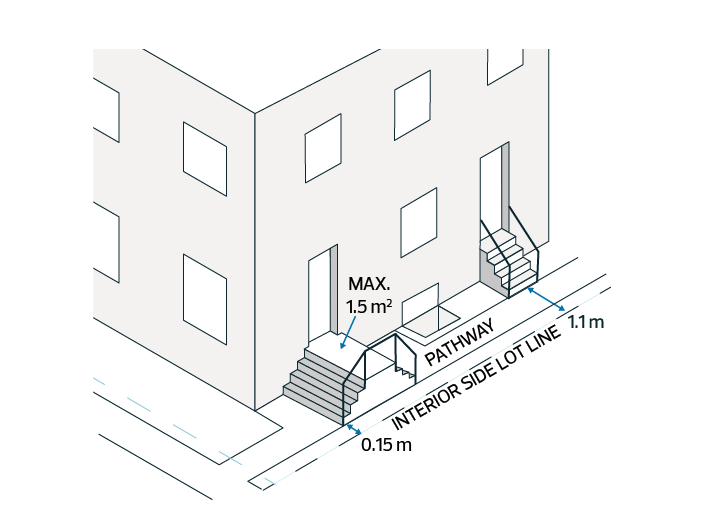To allow for a range of small scale Residential development up to 3 Storeys in Height, including detached, attached, and multi-unit Residential housing. Limited opportunities for community and commercial development are permitted to provide services to local residents.
Residential Uses |
|
| 2.1. | Home Based Business # |
| 2.2. | Residential |
Commercial Uses |
|
| 2.3. | Food and Drink Service |
| 2.4. | Health Service |
| 2.5. | Indoor Sales and Service |
| 2.6. | Office |
| 2.7. | Residential Sales Centre |
Community Uses |
|
| 2.8. | Child Care Service |
| 2.9. | Community Service |
| 2.10. | Special Event |
Agricultural Uses |
|
| 2.11. | Urban Agriculture |
Sign Uses |
|
| 2.12. | Fascia Sign |
| 2.13. | Freestanding Sign |
| 2.14. | Portable Sign |
Residential Uses |
|||||||||||||||||||||||
| 3.1. | Home Based Businesses must comply with Section 6.60. | ||||||||||||||||||||||
| 3.2. | Residential | ||||||||||||||||||||||
|
|||||||||||||||||||||||
Commercial Uses |
|||||||||||||||||||||||
| 3.3. | Food and Drink Services, Health Services, Indoor Sales and Services, and Offices | ||||||||||||||||||||||
|
|||||||||||||||||||||||
| 3.4. | Residential Sales Centres may be approved for a maximum of 5 years. Subsequent Development Permits for Residential Sales Centres on the same Site must only be issued as a Discretionary Development. | ||||||||||||||||||||||
Community Uses |
|||||||||||||||||||||||
| 3.5. | Community Services and Child Care Services | ||||||||||||||||||||||
|
|||||||||||||||||||||||
| 3.6. | Special Events must comply with Section 6.100. | ||||||||||||||||||||||
Agricultural Uses |
|||||||||||||||||||||||
| 3.7. | Urban Agriculture must not be the only Use in a principal building. | ||||||||||||||||||||||
Sign Uses |
|||||||||||||||||||||||
| 3.8. | Signs are limited to On-premises Advertising. | ||||||||||||||||||||||
| 3.9. | Signs must comply with Section 6.90. | ||||||||||||||||||||||
| 4.1. | Development must comply with Table 4.1: |
| Table 4.1. Site and Building Regulations | ||||
|---|---|---|---|---|
| Subsection | Regulation | Value | Symbol | |
| Site Dimensions | ||||
| 4.1.1. | Minimum Site area per Dwelling | 75.0 m2 | - | |
| 4.1.2. | Minimum Site Depth | 30.0 m | A | |
| 4.1.3. | Minimum Site Width | 7.5 m | B | |
| Lot Width for Attached Principal Dwellings | ||||
| 4.1.4. | Minimum Lot Width where the Dwellings are developed on separate Lots not Abutting an Alley | 5.0 m | C | |
| 4.1.5. | Minimum Lot Width where the Dwellings are developed on separate Lots Abutting an Alley | 4.0 m | D | |
Diagram for Subsections 4.1.2, 4.1.3, 4.1.4, and 4.1.5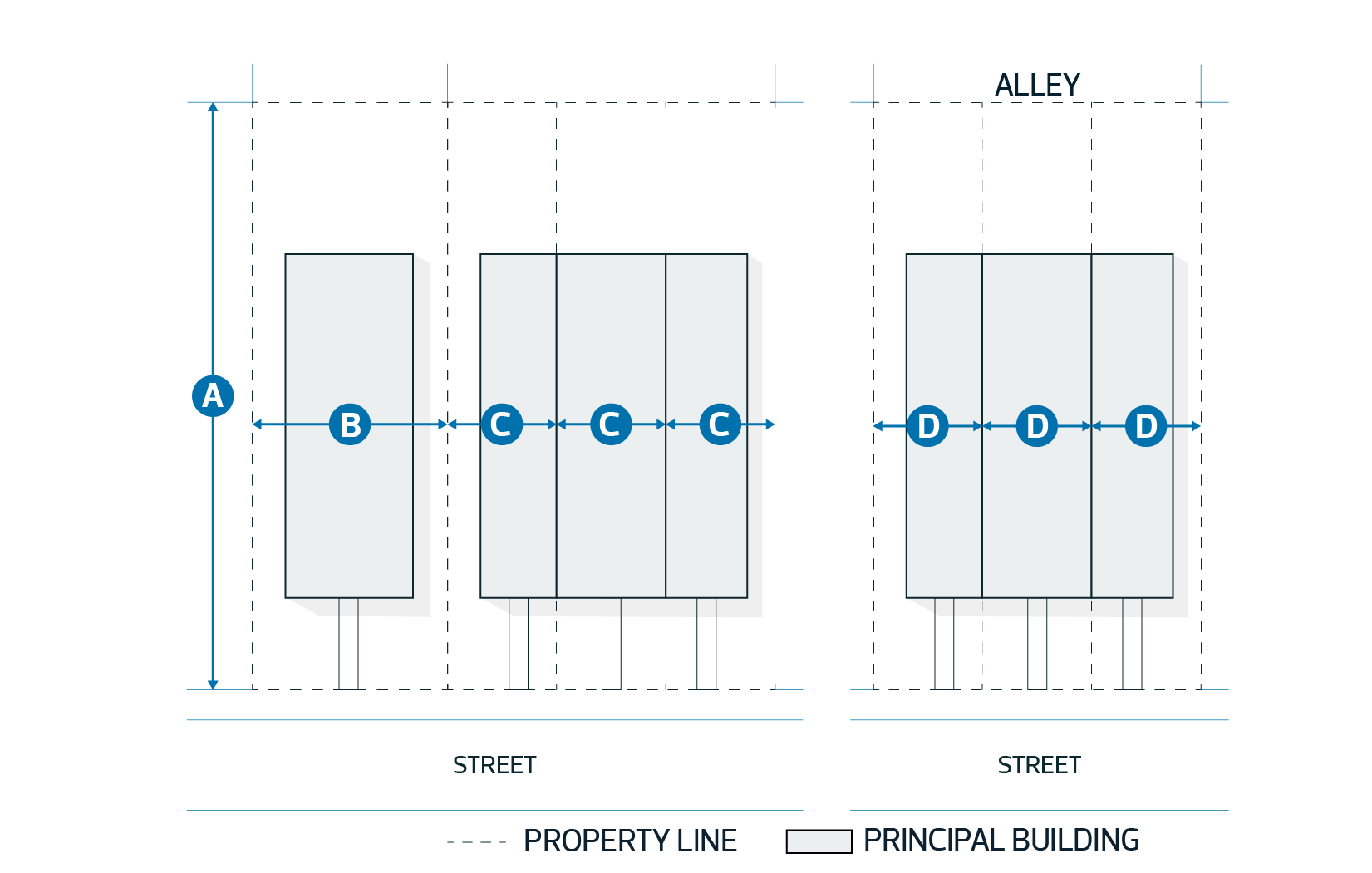
| ||||
| Height | ||||
| 4.1.6. | Maximum Height | 10.5 m | - | |
| Site Coverage | ||||
| 4.1.7. | Maximum Site Coverage | 45% | - | |
| Building Length | a | |||
| 4.1.8. | Maximum building | 30.0 m | E | |
| Unless the following applies: | ||||
4.1.9. | Maximum building length along an Interior Side Lot Line on an Interior Lot | 50% of Site Depth or 25.0 m, whichever is less | F | |
Diagram for Subsections 4.1.8 and 4.1.9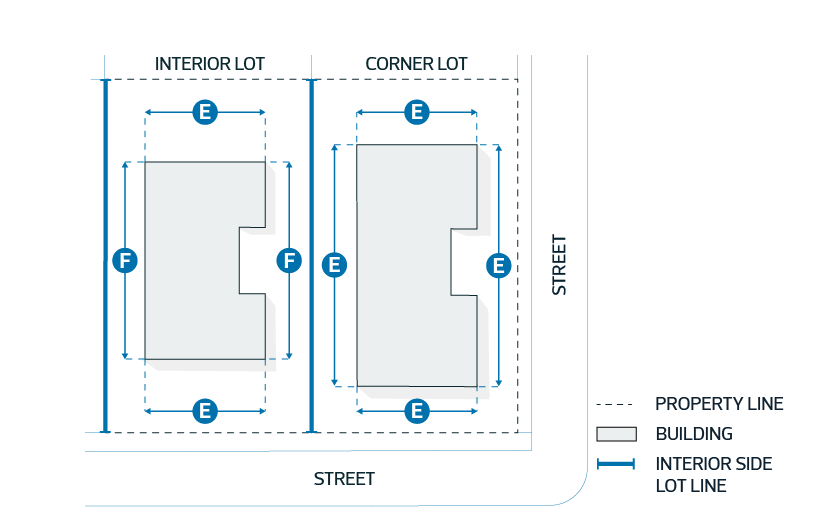
| ||||
| Building Entrances | a | |||
4.1.10. | Maximum number of entrances on the side of a building along the Interior Side Lot Line | 2 | - |
|
Diagram for Subsection 4.1.10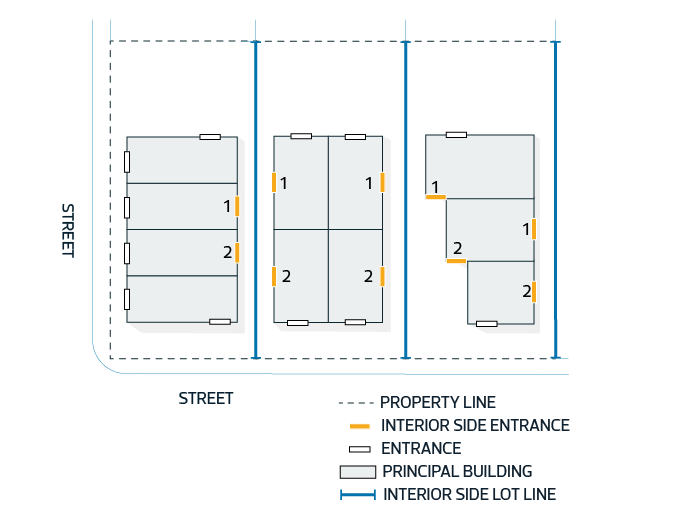
| ||||
| 4.2. | Despite Subsection 4.1.7, the maximum Site Coverage is increased by 2% where: | ||||||
| |||||||
| 4.3. | Setbacks must comply with Table 4.3: |
| Table 4.3. Setback Regulations | ||||
|---|---|---|---|---|
| Subsection | Regulation | Value | Symbol | |
| Front Setback | ||||
| 4.3.1. | Minimum Front Setback | 4.5 m | A | |
Diagram for Subsection 4.3.1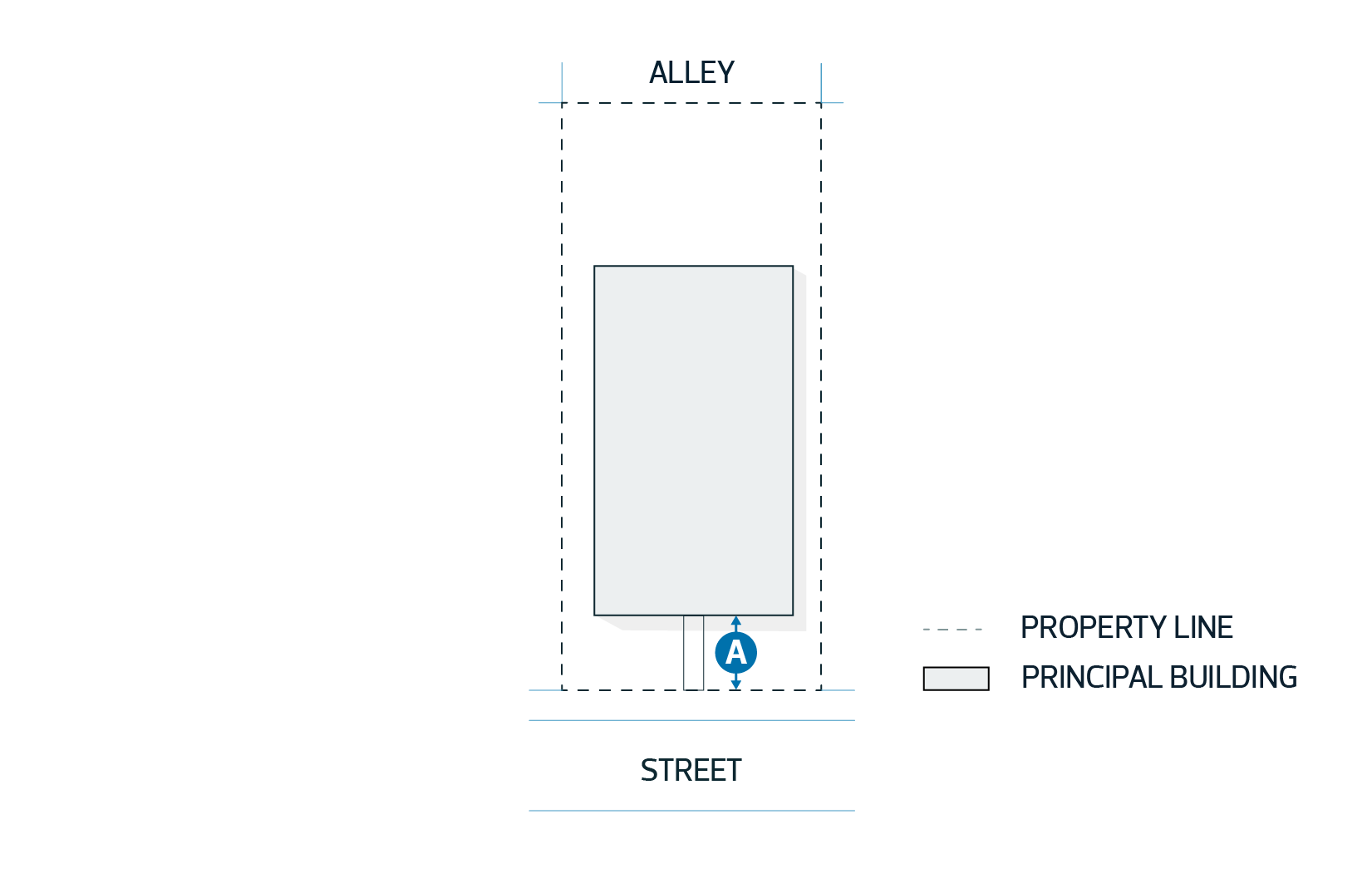
| ||||
| Rear Setback | ||||
| 4.3.2. | Minimum Rear Setback | 10.0 m | B | |
Diagram for Subsection 4.3.2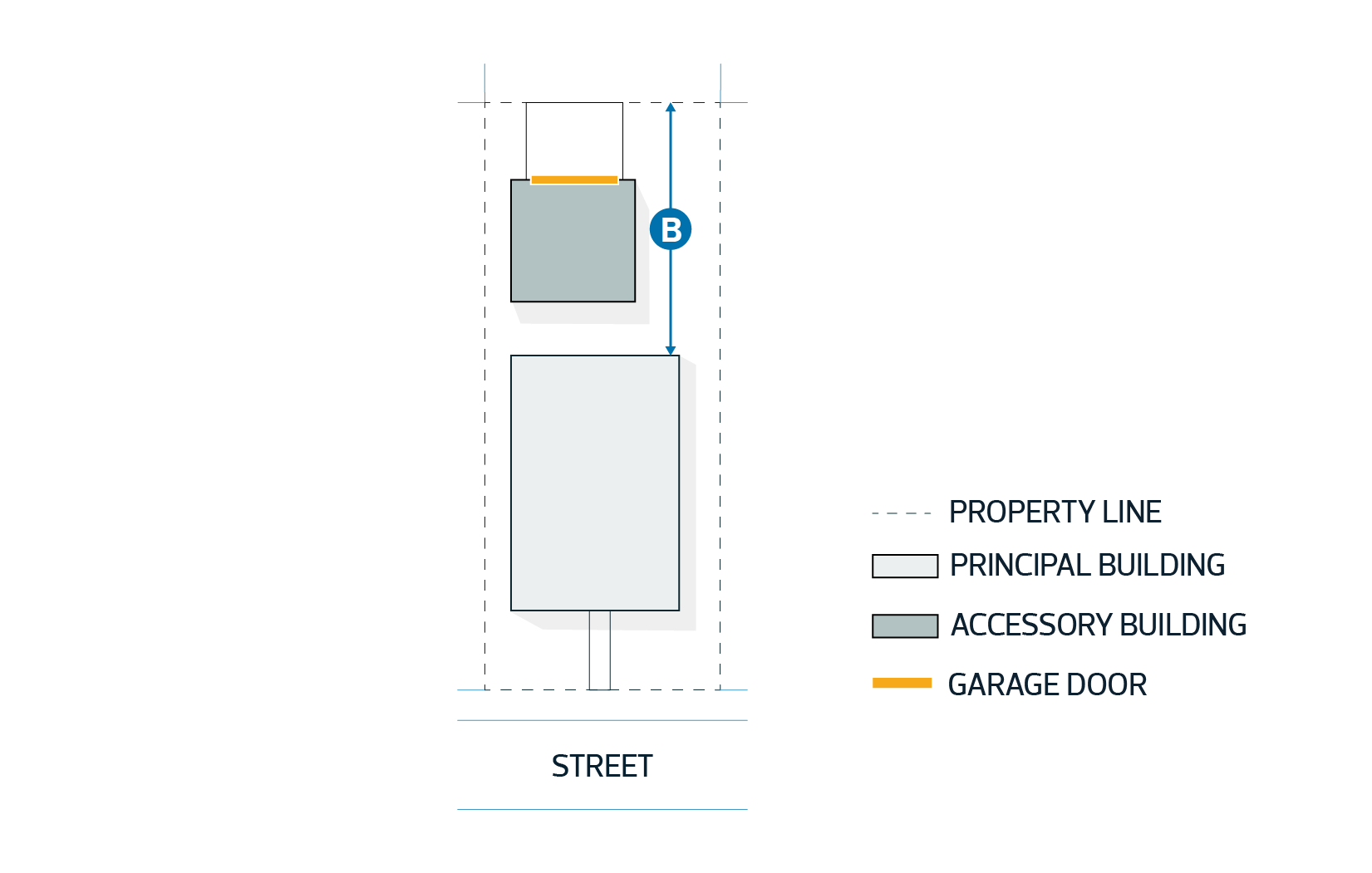
| ||||
| Side Setbacks | ||||
| 4.3.3. | Minimum Interior Side Setback | 1.2 m | C | |
| Unless the following applies: | a | |||
| 4.3.4. | Minimum Interior Side Setback for Row Housing and Multi-unit Housing where an entrance is located on the side of the building along an Interior Side Lot Line | 1.9 m | D | |
Diagram for Subsections 4.3.3 and 4.3.4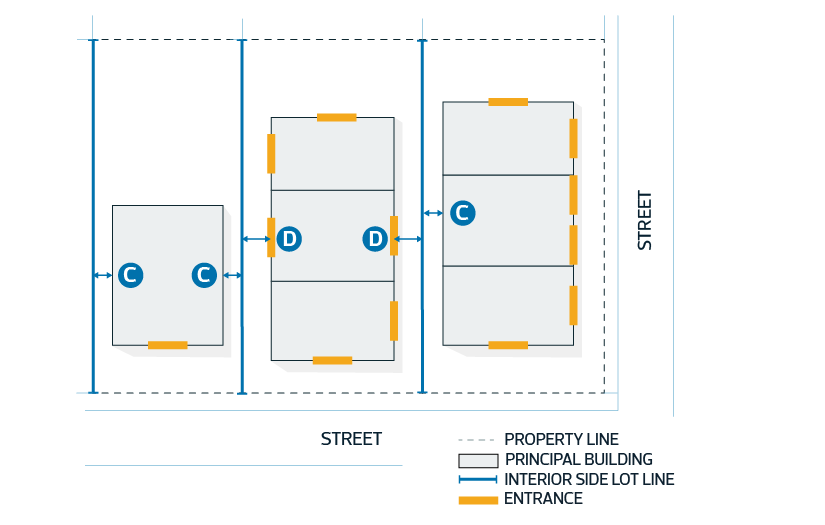
| ||||
| 4.3.5. | Minimum Flanking Side Setback | 1.2 m | E | |
| Unless the following applies: | ||||
| 4.3.6. | Minimum Flanking Side Setback when a main entrance faces a Flanking Side Lot Line | 2.0 m | F | a |
Diagram for Subsections 4.3.5 and 4.3.6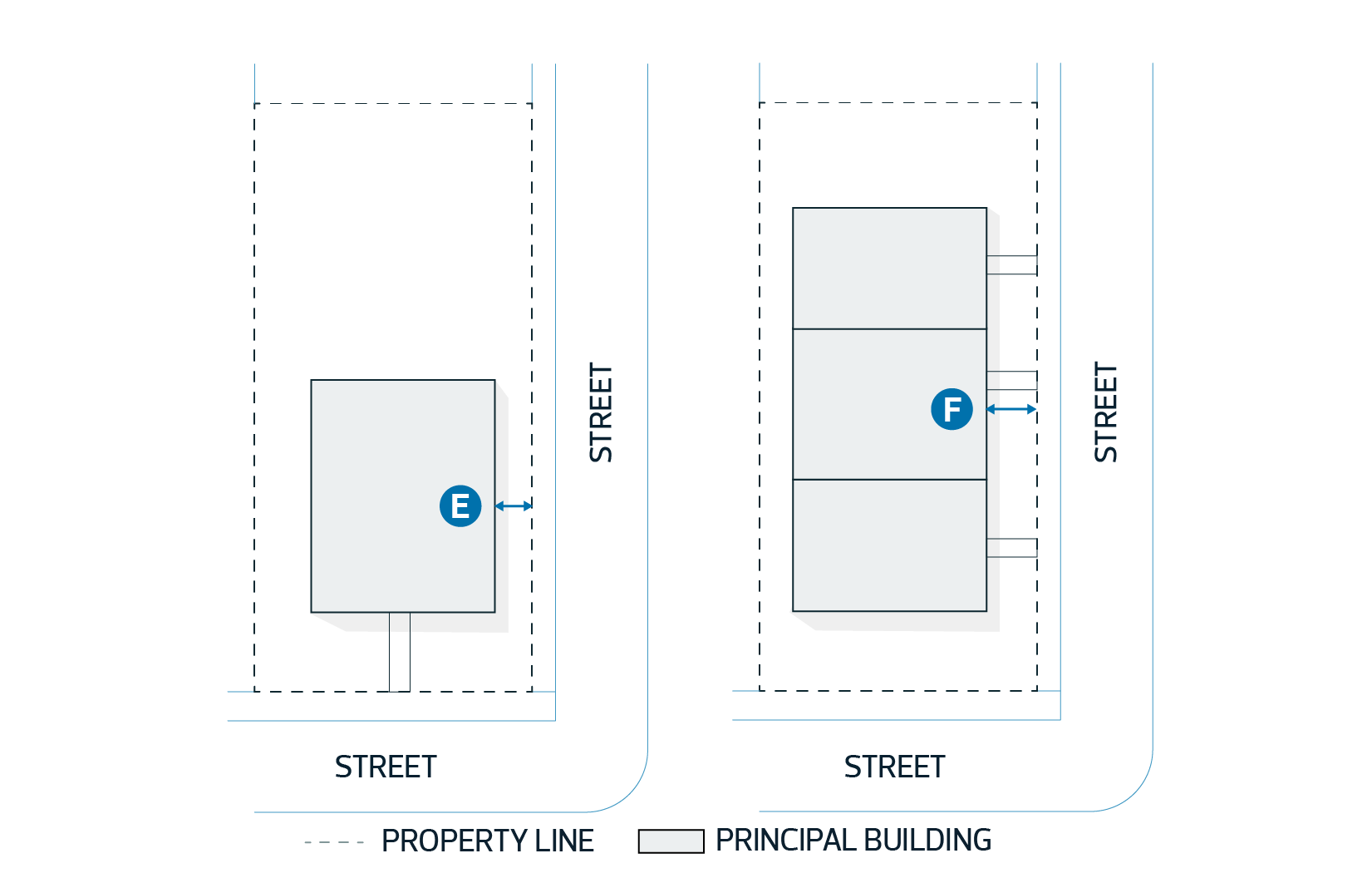
| ||||
| 4.4. | Driveway length must comply with Table 4.4: |
| Table 4.4. Driveway Length Regulations | |||
|---|---|---|---|
| Subsection | Regulation | Value | Symbol |
| Site Area | |||
| 4.4.1. | Minimum Driveway length between a Garage door and the back of an existing or approved sidewalk at the time of the Development Permit application | 6.0 m | A |
| Unless the following applies: | |||
| 4.4.2. | Minimum Driveway length between a Garage door and the Front Lot Line or Flanking Side Lot Line, where there is no existing or approved public sidewalk at the time of the Development Permit application | 5.5 m | - |
Diagram for Subsection 4.4.1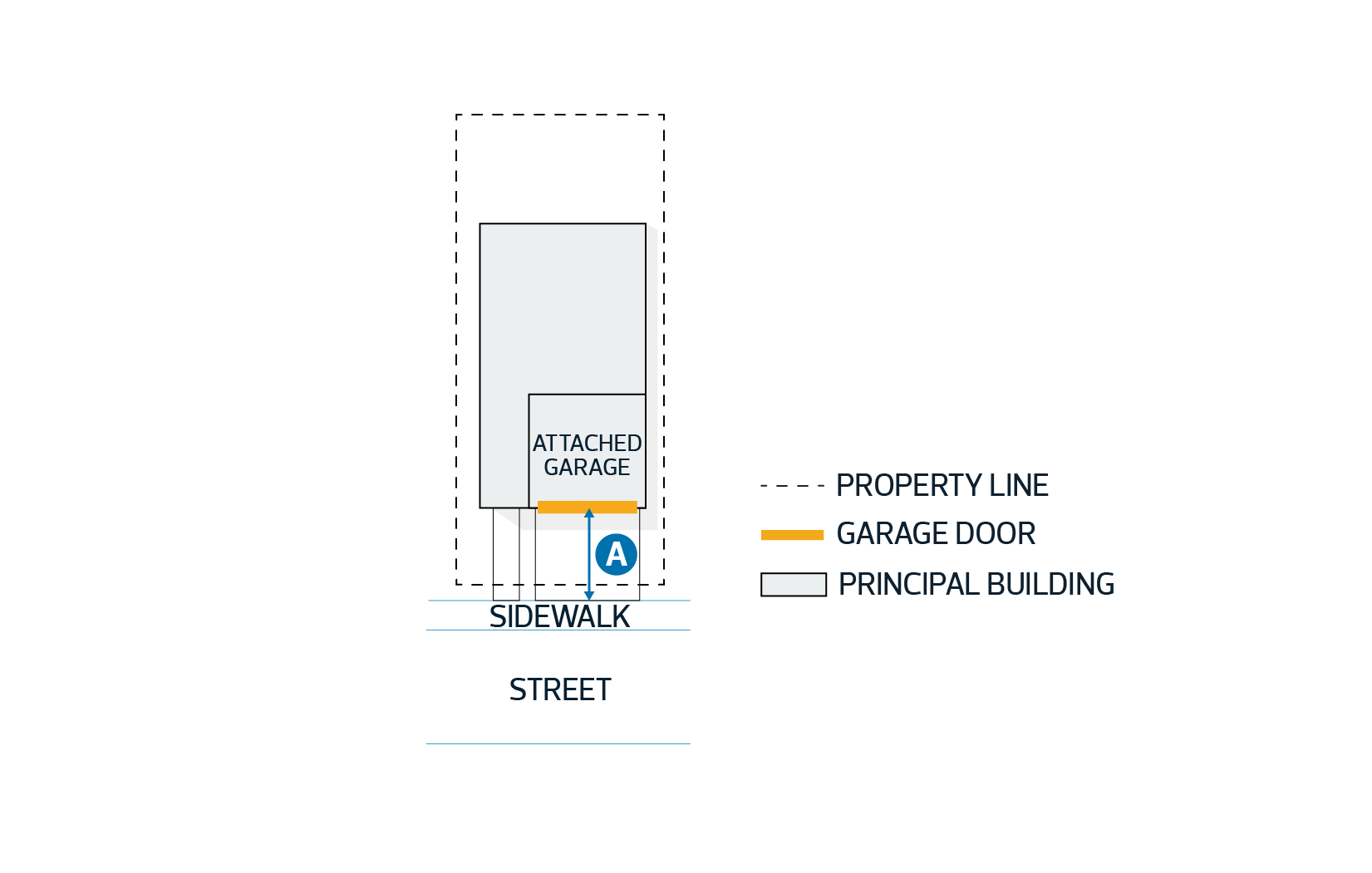
| |||
| 4.5. | The minimum distance between a rear detached Garage and a principal Dwelling, except for Backyard Housing, on the same Site is 3.0 m. | |||||||||
| 4.6. | Despite Section 5.90.2 to Section 5.90.5, unenclosed steps may project into a required Setback as long as the unenclosed steps: | a | ||||||||
| ||||||||||
| 4.7. | In addition to Subsection 4.6, unenclosed steps may only project into a required Interior Side Setback where they have a maximum Height of 1.0 m. | a | ||||||||
| 4.8. | Despite Subsection 4.6.1: | a | ||||||||
| ||||||||||
Building Design Regulations | |||||||||||
| 5.1. | Where a building wall: | ||||||||||
| |||||||||||
| 5.2. | Despite Subsection 5.1, where a building wall for Row Housing or Multi-unit Housing: | a | |||||||||
the Facade must be articulated using 2 or more design techniques to minimize the perception of massing, eliminate large blank walls, provide visual interest, and accentuate main entrances facing the Street. Design techniques may include those described in Subsection 5.1, other than windows, balconies, and porches. | |||||||||||
| 5.3. | Identical or mirrored front Facades are not permitted on Abutting Sites. Developments on Abutting Sites must be differentiated by 2 or more design features. This does not apply to attached Dwellings within the same building. | ||||||||||
| 5.4 | On Corner Sites, all principal building Facades facing a Street must use consistent exterior finishing materials and architectural features and include features such as windows, doors, or porches. | ||||||||||
Entrance and Window Design Regulations | a | ||||||||||
| 5.5. | All principal ground-oriented Dwellings and non-Residential Uses adjacent to a Front or Flanking Side Lot Line must have a main entrance door, porch, or landing facing either the Front or Flanking Side Lot Line, except: | ||||||||||
| |||||||||||
| 5.6. | All principal Row House Dwellings adjacent to a Front Lot Line on an Interior Site must be oriented towards the Street. The Street-facing Facade of each Row House Dwelling adjacent to the Front Lot Line must: | a | |||||||||
| |||||||||||
| 5.7. | All Cluster Housing and Multi-unit Housing principal buildings adjacent to a Street must have at least 1 main entrance: | ||||||||||
| |||||||||||
| 5.8. | Where Multi-unit Housing has a building wall length greater than 12.8 m and fronts onto a Street with an existing or approved sidewalk, each Ground Floor Dwelling along that wall must have an individual entrance with direct ground level access to a Street with an existing or approved sidewalk. | a | |||||||||
| 5.9. | Sliding patio doors must not serve as the main entrance of a Dwelling. | a | |||||||||
| 5.10. | Main entrances for Multi-unit Housing must incorporate weather protection features in the form of canopies, awnings, overhangs, vestibules, recessed entrances or other architectural elements to provide all-season weather protection to pedestrians and to enhance the visibility of entrances. | ||||||||||
Parking, Loading, and Access |
|
| 6.1. | Vehicle access must be from an Alley where a Site Abuts an Alley. |
| 6.2. | Rear attached Garages are not permitted. i |
| 6.3. | Where permitted, the maximum Garage door width for a front attached Garage is 60% of the total length of the front building wall. |
| 6.4. | Surface Parking Lots must not be located between a principal building and a Street. |

